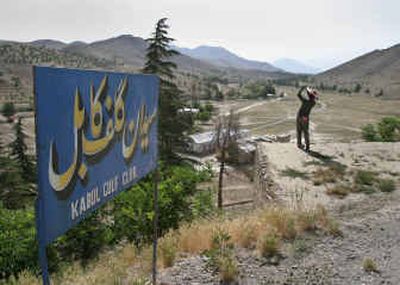Outings are rough, but golf returns to Afghanistan

KABUL, Afghanistan – Never mind that the fairway was just a muddy hillside.
Or that the green was a patch of sand smoothed with black motor oil.
Mohammed Hashem prepared to tee off with all the concentration of his new hero, Tiger Woods.
“Check the condition of the ground first,” warned his instructor, Mohammed Afzal Abdul.
It’s an essential precaution on the rock-strewn links of the Kabul Golf Club, which reopened on the outskirts of Afghanistan’s capital last spring after more than two decades of war and neglect.
Like the rest of the country, the government-owned course is something of a work in progress. Landscapers have dragged away most of the weapons and shrapnel that littered the grounds, though a rusted Russian tank still stands sentry atop one of several hills ringing the course. A large metal shipping container has been brought in to replace the old clubhouse, now a bombed-out shell.
Abdul, the club’s director in addition to its pro, has also built a water hazard. Someday soon, he hopes to fill it with water.
The rough, at least, is world-class.
Despite the challenges posed by the nine-hole course, about 100 diplomats, aid workers and other foreigners paid a small fee to golf here last year. With the club’s second season about to begin, Abdul, a slim, athletic-looking man in his 40s, is keen to attract a larger crowd.
“If I could get funds from the Americans or maybe the British, I could put a fence all around the course to keep the foreigners safe,” he said. “Then we will need a well, so we can grow grass, and plumbing so we can build a new clubhouse.”
Still, he said, his priority was the roughly 50 Afghan students he has been teaching free all winter.
“I know they have a bright future in golf. And that makes me feel very happy,” Abdul said.
His students, mostly college-age men, wear sneakers and green caddy vests pulled over the long tunics and billowing trousers traditionally worn by Afghans. They said they like golf because it allows them to exercise and unwind at the same time. But their thirst for leisure sometimes has deeper roots.
Mohammed Ayub, 23, left school at age 12 to work as a construction laborer after his father died and civil war forced his family to flee to Pakistan. Now, finally back in school as a 10th-grader, he is beginning to recover some of his lost youth.
The students can also earn about $3 a game caddying for foreigners. But Hashem, 19, harbors grander ambitions, fueled in part by glossy golf magazines, filled with photos of Tiger Woods, that foreign players have shown him.
“I want to become a champion like him, so I can make Afghanistan famous,” Hashem said. Last November he got off to a promising start, winning third place in the club’s first tournament in nearly 30 years. It was open only to Afghans.
During a recent lesson, though, Hashem was in less than perfect form.
“This ball has just decided not to move,” he grumbled after three unsuccessful swings drew chuckles from his classmates.
Other students said they had never heard of golf until they happened to pass by the course.
“The game seemed interesting and I wanted to try it,” said Sayed Mohammed, 20, who started his lessons with Abdul seven months ago. Soon, he said, he was hooked. He leaves his village before dawn to walk 40 minutes to the course.
The Kabul course had been turned into a battlefield by a succession of warring militia factions, culminating with the extremist Taliban militia.
Then, in 2001, the Taliban was defeated by U.S.-led forces. Several Afghans persuaded the new government to allow the club’s reopening and have leased the grounds for 20 years, although so far they appear to have invested relatively little. A U.N. employee donated several sets of clubs, and a de-mining agency agreed to check the course for old land mines.
If there was any hope of recapturing the club’s glory days, however, Abdul was needed. Fortunately, he had just moved back to Kabul.
The $80 per month he was offered as director of the golf club was less than what he was making as a taxi driver.
“But I felt it was my duty to accept,” Abdul said.
Besides, he said, it felt good to return to the source of so many happy memories.
“When I see my students, I remember the days when I was learning, and I think of all the parties and the fun times at the club,” he said. “Then I become young again too.”